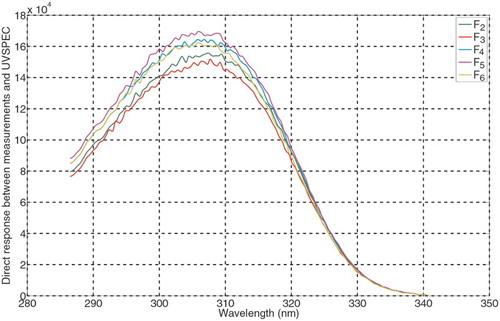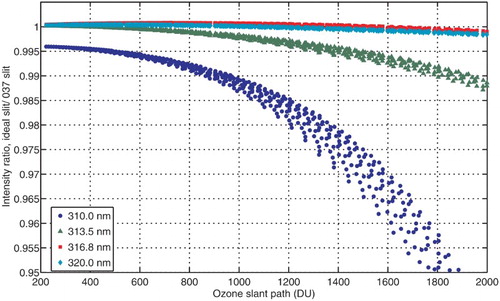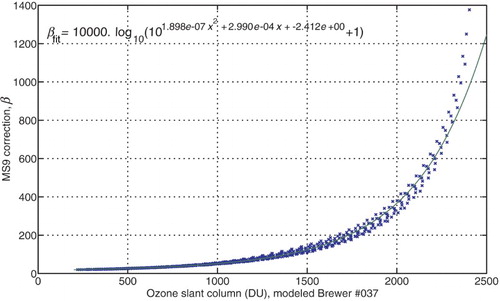Abstract
Spectrometers are designed to isolate particular wavebands and suppress light from wavelengths outside the band of interest. However, a small amount of undesired light will always enter the detector, not through the designed optical path, but through random scattering from the instrument optical components, housing, and dust particles. Every spectrophotometer has stray light coming from outside the nominal measurement waveband. For Dobson spectrophotometers and single monochromator Brewer spectrophotometers, which are basic instruments in the World Meteorological Organization (WMO) ozone and ultraviolet (UV) monitoring network, the error introduced by stray light is substantial when the ozone slant path becomes very large because of high solar zenith angles and a thick ozone layer. These are common conditions during Arctic spring. To study the issue, a long ozone slant path Intercomparison/Calibration campaign for Nordic Brewers and Dobsons was held at Sodankylä 8–24 March 2011 and a follow-up campaign to extend calibrations to shorter ozone slant paths took place at Izaña observatory, Tenerife, between 28 October and 18 November 2011. These campaigns were part of the Committee on Earth Observation Satellites (CEOS) Intercalibration of Ground-based Spectrometers and Lidars project funded by the European Space Agency (ESA), intended to permit the homogenization of ozone data from the European ozone ground-truthing network. During the active intercomparison periods, measurements were taken only when good conditions for sun or moon observations existed. Laboratory measurements using calibration lamps and helium-cadmium (HeCd) lasers were an essential part of both campaigns. The campaigns produced a high-quality database of total ozone and UV measurements and an accurate, up-to-date calibration and characterization of participating Brewers and Dobsons against the European standard instruments from the Regional Dobson Calibration Centre-Europe (RDCC-E) and the Regional Brewer Calibration Centre-Europe (RBCC-E). In the present work we focus on single monochromator Brewers and present a physics-based method to compensate for the stray-light effects in ozone retrieval using laboratory characterizations and radiative transfer modelling. The method was tested with independent data from the campaign.
Résumé
[Traduit par la rédaction] Les spectromètres sont conçus pour isoler des gammes de longueurs d'onde particulières et supprimer la lumière de longueurs d'onde différentes qui se trouve en dehors de la gamme d'intérêt. Cependant, il y a toujours une petite quantité de lumière indésirable qui entre dans le détecteur, non pas par le chemin optique prévu mais par suite d'une diffusion aléatoire par les éléments optiques de l'instrument, le boîtier et les particules de poussière. Il y a dans chaque spectrophotomètre de la lumière parasite ne faisant pas partie de la gamme de longueurs d'onde nominale d'intérêt. Pour les spectrophotomètres Dobson et les spectrophotomètre à monochromateur Brewer, qui sont des instruments de base dans le réseau d'observation de l'ozone et des ultraviolets de l'Organisation météorologique mondiale (OMM), l'erreur introduite par la lumière parasite est importante quand le trajet oblique dans l'ozone devient très grand en raison des angles zénithaux solaires élevés et d'une couche d'ozone épaisse. Ces conditions sont courantes durant le printemps arctique. Pour étudier la question, une campagne d'intercomparaisons/étalonnage pour les longs trajets obliques dans l'ozone pour les Brewers et les Dobsons nordiques a eu lieu à Sodankylä du 8 au 24 mars 2011 et une campagne de suivi ayant pour but d’étendre les étalonnages à des trajets obliques plus courts dans l'ozone a eu lieu à l'observatoire Izaña, à Tenerife, entre le 28 octobre et le 18 novembre 2011. Ces campagnes faisaient partie du projet d'interétalonnage des spectromètres et des lidars basés au sol du Comité sur les satellites d'observation de la Terre (CEOS) financé par l'Agence spatiale européenne (ASE) et ayant pour but de permettre l'homogénéisation des données sur l'ozone du réseau européen de vérification au sol de l'ozone. Au cours des périodes pendant lesquelles les intercomparaisons ont eu lieu, des mesures ont été prises seulement quand les conditions d'observation du soleil ou de la lune étaient bonnes. Des mesures en laboratoire faites au moyen de lampes d’étalonnage et de laser à hélium-cadmium (HeCd) formaient une partie essentielle des deux campagnes. Les campagnes ont produit une base de données de haute qualité de mesures d'ozone total et d'UV ainsi qu'un étalonnage et une caractérisation précis et à jour des Brewers et des Dobsons participants en regard des instruments européens normalisés du Centre régional d’étalonnage Dobson pour l'Europe (RDCC-E) et du Centre régional d’étalonnage Brewer pour l'Europe (RBCC-E). Dans le présent travail, nous nous intéressons plus particulièrement aux Brewers à monochromateur unique et présentons une méthode basée sur la physique pour compenser les effets de la lumière parasite dans l'extraction d'ozone au moyen de caractérisations en laboratoire et de la modélisation du transfert radiatif. La méthode a été testée avec des données indépendantes de la campagne.
1 Introduction
The Brewer spectrophotometer was originally designed to measure total ozone and was later modified to also make solar ultraviolet (UV) radiation measurements. For wavelength separation, the Brewer contains a modified Ebert monochromator, utilizing a holographic diffraction grating. There are several versions of Brewer spectrophotometers of which the MkII, MkIV, and MkV contain a single monochromator, and the MkIII has two monochromators set in series. For all the versions the grating(s) can be rotated, and there are six different exit slits through which the light from the monochromator is guided to a photomultiplier (SCI-TEC Instruments Inc., Citation1999). The individual exit slits can be opened or closed using a rotating mask.
The main operation modes for Brewer spectrometers are the UV-scan and the direct sun (DS) ozone measurement. In the UV-scan global irradiance is measured through a UV-port, a window with a teflon diffuser and a quartz dome. The diffraction grating is turned so that the wavelength of light reaching the photomultiplier through an exit slit changes, and the intensities at different wavelengths are measured over a 6-minute interval. For the MkII, using only one slit for the scan, usually wavelengths from 290 to 325 nm are measured with a step of 0.5 nm. Beyond 325 nm the signal is strongly attenuated by a cut-off filter. The MkIII and MkIV, with slightly modified hardware, extend the wavelength range by using two different slits during the scan and can reach longer wavelengths, measuring up to 365 nm routinely.
In the ozone measurement mode, direct sunlight is collected through a flat quartz window and guided towards the entrance slit by a zenith prism. The grating is kept stationary and an exit slit mask is rotated rapidly to expose each slit sequentially, resulting in near-simultaneous measurement of five wavelengths, four of which are used in ozone retrieval. By knowing the weighted differential absorption at these selected wavelengths, the total ozone column and total sulphur dioxide column can be determined.
Because of the finite dimensions of the exit slits, measurements are always made for a narrow band of wavelengths, not a single wavelength. As a result of imperfections in the diffraction grating, the other optical components of the Brewer, and dust particles, the intensity measured will always contain some radiation from wavelengths outside the desired waveband. This excess light is called stray light. Because spectral intensity increases rapidly as a function of wavelength, a large fraction of intensities measured at lower wavelengths can consist of stray light originating from the long wavelength end of the measured spectrum. The effects are most evident at short wavelengths in UV-scans and in DS measurements made at large ozone slant column amounts.
The amount of stray light depends on the instrument design. The stray-light rejection efficiency is typically two to three orders of magnitude better for the double monochromator Brewers than for the single monochromator versions (see ). The effect is clearly evident in the intercomparison campaigns. Compared with double Brewers, total ozone values measured with a single Brewer, tend to dip in the early morning and late evening when the solar zenith angle is large—especially when total ozone is high. In the Arctic spring the effect is often visible even at noon.
Fig. 1 Slit functions measured with an HeCd-laser for the single Brewer #037 and a double Brewer #107 at Izaña 2011. For Brewer #107 there are some spikes in the wing caused by internal reflections. On average, for Brewer #037 the relative intensity outside the triangular core is about two orders of magnitude higher than the relative intensity for Brewer #107.
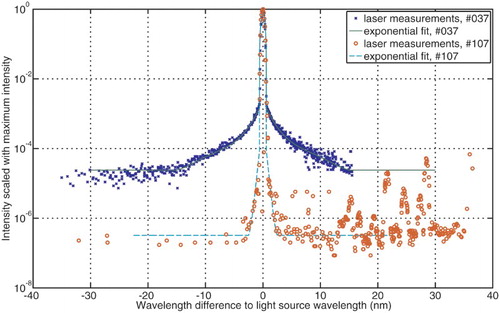
There are currently no commonly accepted methods for correcting the Brewer total ozone error introduced by stray light although several suggestions can be found in conference abstracts and work group reports published on the internet (Kiedron, Disterhoft, & Lantz, Citation2008; V. Savastiouk and C.T. McElroy, personal communication, 2011; C.A. McLinden personal communication, 2011). On the other hand, several papers have been published which deal with the correction of stray light in diode-array spectrometers that measure the entire UV spectrum instantaneously. These are based on the inversion of the matrix representing the slit function. Prior to inversion, the matrix is modified to the easily invertible Toeplitz matrix by zeroing slit function values around the central maximum out to the somewhat arbitrarily chosen first stray-light pixel (Brown et al., Citation2003; Kreuter and Blumthaler, Citation2009; Ylianttila, Visuri, Huurto, & Jokela, Citation2005; Zong, Brown, Johnson, Lykke, & Ohno, Citation2006). The method is not the best alternative for the Brewer, even if the DS ozone measurement is a fairly rapid process because only five wavelengths are measured. In the case of Brewer UV spectral measurements the spectrum is not acquired instantaneously but over about six minutes, a period of significant duration. The method we present here has been discussed before (e.g., Kiedron et al., Citation2008) but not published earlier as a full paper nor applied to real atmospheric data.
The paper is set up in the following manner. In the first two subsections of Section 2 the dataset is introduced and a short description of the Brewer ozone retrieval is given. The next three subsections describe the method for instrument characterization and explain the methodology of expressing the instrument characteristics in the model used. In the last subsection of Section 2 the correction, based on the model runs, is presented. In Section 3 corrections are tested using real data measured during the Committee on Earth Observation Satellites (CEOS) campaigns. Finally, the results are summarized, and some new ideas to improve the correction method are presented.
2 Data and methods
a Data
In this study, data collected during the campaigns held at Sodankylä during Arctic spring conditions (March 2011) are considered as well as measurements made a few months later at the subtropical Izaña observatory (November 2011). There were 1396 pairs of nearly simultaneous measurements from single Brewer #037 and reference Brewers from the Regional Brewer Calibration Centre-Europe (RBCC-E), covering ozone slant paths from 360 to 2500 Dobson Units (DU; 1 DU = 0.01 mm at standard temperature and pressure and is equivalent to 2.69 × 1020 molecules per square metre). The campaigns were part of the 2011 CEOS Intercalibration of Ground-based Spectrometers and Lidars project sponsored by the European Space Agency (ESA). The observations from these campaigns and the calibration checklist where the calibration results are summarized are available at the RBCC-E web page www.rbcc-e.org. In this paper a physical correction method is proposed by which the single Brewer DS total ozone measurements can be corrected to correspond to those of double Brewers. The method requires careful characterization of the instrument's stray light and response properties. The UV measurements are outside the scope of this work because during the long recording time of a UV spectrum the solar zenith angle changes and sky conditions can also change. This requires a different approach to that appropriate for the nearly instantaneous ozone measurement.
b Brewer Ozone Retrieval
The Brewer spectrophotometer total ozone retrieval is based on calculating weighted ratios of photon count rates resulting from the spectral intensities at four wavelengths: F3 (λ3 approximately 310.0 nm), F4 (λ4 approximately 313.5 nm), F5 (λ5 approximately 316.8 nm), and F6 (λ6 approximately 320.0 nm). The weighting factors (powers) have been selected to minimize the effects of aerosols and sulphur dioxide. The double ratio, denoted as MS9 in the Brewer operating software, is calculated as in (SCI-TEC Instruments Inc., Citation1999):(1)
Total ozone column, MS11, is calculated from MS9 using the following equation:(2) where μ is the air mass coefficient meaning the relative optical path through the ozone layer compared to the path at a solar zenith angle of 0 degrees; ETC corresponds to MS9 above the atmosphere; and α is the weighted combination of wavelength-specific absorption coefficients. In principle, the absorption coefficient should be calculated from a known absorption spectrum, currently Bass and Paur (Citation1985), and the extraterrestrial coefficient from a Langley plot. Often, however, these are transferred in intercomparison campaigns from calibrated reference Brewers, in this work from the members of the RBCC-E triad. The calibration and characterization process is described in following sections.
c Characterizing the Spectrophotometer
The photon count rate through the exit slit n, Fn, measured by the Brewer is the integral of the spectral intensities at all wavelengths, I(λ), weighted by the slit function, S, and the device response, Rn(3)
Slit function and response are individual properties for each Brewer and need to be characterized in order to model the behaviour of count rates in different atmospheric conditions.
The slit function defines the stray-light properties of the instrument. It describes the spread of light at a specific wavelength with respect to other wavelengths for a Brewer. The characterization is done by measuring a narrow spectral line of an HeCd-laser at 325 nm and scanning through all wavelengths, starting at 290 nm. All the slits used for measuring ozone have been characterized. Because the stray-light properties of the slits are very similar, a single average slit function, shown in , is used for all the slits. The slit function S(λ) is then represented by lines over three different ranges: the central triangle (full width half maximum (FWHM) = 0.6 nm), the exponential wing region, and the flat outer region (shown in ). As an example of a double Brewer slit function the measurement and fit for Brewer #107 is presented. For a model reference double Brewer, however, the ideal case has been chosen, and the slit function consists only of a triangle with an FWHM of 0.6 nm.
Table 1. Slit function fits for Brewers #037 and #107. Fits have been divided into three parts: a triangular core with FWHM 0.6 nm, an exponentially decaying wing, and a flat outer region.
Response is wavelength dependent and gives the correspondence between intensity of the light source and the count rate measured. For characterizing the response, a 1000 W reference lamp, with an accurately known spectrum, is used as the light source. Response is obtained by dividing the measured count rate by the reference lamp spectrum. The global response of Brewers are customarily used only for UV measurements and, therefore, measured through the UV port. Because the intensities are measured through different exit slits in total ozone measurements, and each of the five slits transmits over a slightly different wavelength range, it is, in principle, necessary to characterize each slit individually. For the purposes of this work, it is reasonable to assume that the slit function is similar for all the slits, whereas it is important to consider the individual responses Rn(λ) separately. To account for the stray light coming from the wavelengths beyond the scope of a particular slit (λst
,n – λend,n), it is important to extend responses Rn of each slit as far as possible. In practice, measurements from approximately 286.5 to 340 nm can be reached with most single Brewers. The nickel sulphate (NiSO4) filter is expected to cut out light so that stray light from beyond 340 nm is insignificant. Here, the response of the long wavelength slit, number 6, is scaled to extend the response of other slits from λend
n
to longer wavelegths (λ+) until λend,6. At the short wavelength end (λ−), slit number 0 is used to extend all the responses to start at 286.5 nm, where the atmosphere no longer transmits solar UV. The reconstruction of the resulting global responses can be presented as(4a)
(4b)
d Reconstruction of the DS Response
To be precise, the stray-light correction of ozone measurements would require a measurement of the DS response RDS,n as has been done for some single Brewers, to use them for Aerosol Optical Depth (AOD) measurements (Bais, Citation1997; Gröbner & Meleti, Citation2004; Kazadzis et al., Citation2005). Because the DS response calibration has not been done for Brewer #037, for this work the DS response has been reconstructed from the global response Rg,n. It is assumed that the shape of the DS response will be the same as the global response. The global response is scaled with the help of a radiative transfer model so that the modelled count rates match the real measured DS count rates Fmeasured,n. For this purpose we used the LibRadtran 1.6-beta package and UVspec sdisort version (this code is freely available from http://www.libradtran.org). We chose the best measurement day during the Izaña campaign, 31 October 2011, when the sky conditions and ozone layer were stable. Using real count rates at low zenith angles, a scaling factor, rn, for slit n is calculated:(5) where I(λ) is the modelled solar irradiance. The model-constructed DS responses RDS,n(λ) = rnRg,n(λ) for Brewer #037 is shown in . The size of the scaling factor rn is reasonably similar to the ratios between the DS and global responses obtained earlier through measurements (e.g., in Gröbner & Meleti, Citation2004; Kazadzis et al., Citation2005).
eAdditive Correction
In the model-based correction, it is assumed that, because of stray light, there will be an ozone and air mass dependent ratio, an, between double Brewer (ideal slit) count rates and single Brewer (#037 slit) count rates Fn. Hence, from Eq. (1), reference Brewer double ratio MS9ref becomes:(6)
With some logarithmic algebra we end up with a single additive correction coefficient, β, to the single Brewer double ratio MS9si
(7)
In the equations above, MS9ref refers to the double ratio of an idealized reference Brewer with a triangular slit function, and MS9si is the double ratio of a single Brewer having a real slit function as depicted in . The two model Brewers have the same DS response. The sequence of tasks required to obtain β is illustrated in Figs to . First, using Eq. (2) the calibration coefficients ETC and α of the model Brewers are estimated by creating a linear fit to simulated measurements against model input total ozone slant column. To reduce stray-light effects on calibration constants, slant paths less than 800 DU have been used in estimating ETC and α, represented by the y-axis intercept and slope of the fitted lines in . To obtain the count rate ratios, an, needed to calculate β, the simulations were run over a large number of air mass and ozone values covering slant paths from 220 to 2800 DU (). Next, the one-dimensional look-up array β(MS11si
μ) is created (Eq. (7)) and made continuous by fitting the exponential function(8) which then gives the stray-light correction to arbitrary values of μMS11si, shown in . Once the β-correction has been created through instrument characterization and radiative transfer RT model simulations, the system can be applied to observations. Outwith the intercomparison campaigns we do not have a model or reference Brewer so it is important to reference the correction table to a single Brewer total ozone measurement as emphasized in .
3 Results
As an example, the dataset from the 2011 Sodankylä and Izaña campaigns has been stray-light corrected with the method described above. First the Brewer #037 extraterrestrial and absorption coefficients, ETC and α, respectively, were updated by transferring the calibration from Brewer #157, a member of the RBCC-E Brewer triad, using simultaneous measurements under stable sky conditions at slant paths smaller than 800 DU. This is done to match small ozone slant column measurements, where stray light has very little effect, making the comparison at high slant paths easier. Using the updated constants, MS11037 was calculated and the correction β(MS11037
μ) was applied to MS9. A second calibration round is performed using the preliminary corrected MS9c to arrive at the final constants ETCc and αc (). Finally the ozone is calculated with the corrected MS9 and new constants:(9)
Fig. 6 Brewer #037 ETC and absorption coefficients fitted for original and stray-light corrected data to match Brewer #157 at low air mass values.

and show the results. Because the Izaña data below a slant path of 800 DU was used to obtain the calibration coefficients, it is understandable that there is excellent agreement there. Other data from Izaña and all the data from the Sodankylä campaign represent an independent dataset which can be used to evaluate the efficiency of the correction. It is evident that the correction reduces the stray-light error but is not sufficient to bring the longest slant path data into perfect agreement with the two double Brewers of the European calibration triad, Brewer #157 (used at Izaña) and the travelling reference Brewer #185 (used at Sodankylä). On the other hand, the largest air mass coefficient used in is 6 (typical ozone values in the Sodankylä campaign of 2011 were 400–450 DU), and in this regard the improvement is impressive indeed. It is unrealistic to think that any correction method could work perfectly with the highest slant paths but the correction of 4–5% (i.e., typically 15–20 DU) brought the single Brewer measurements, made at high zenith angles, within 1% to 1.5% of reference double Brewer measurements. At Arctic sites this would make it possible to start measurements significantly earlier in winter and/or spring and push the end of the useful measurement season further into autumn.
Fig. 7 Relative difference between Brewer #037 total ozone columns and Brewer #185/#157 total ozone columns before and after stray-light correction.
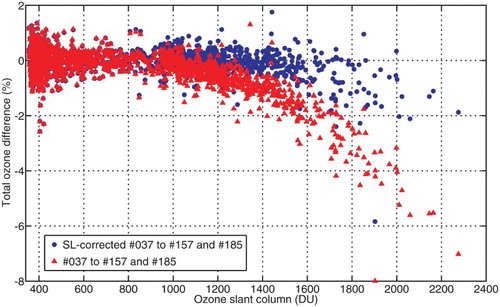
Table 2. Statistics of relative differences between the single Brewer #037 and double Brewer #157/#185 ((MS11037 − MS11157/185)/MS11157/185) before and after the stray-light corrections have been applied. Statistics have been divided into nine areas (columns) according to the ozone slant column of the double Brewers.
4 Summary and discussion
Stray light leads to the underestimation of total ozone in single Brewer measurements at large slant column amounts of ozone, a common situation when making measurements in the Arctic spring. The stray-light effect is particularly severe in single monochromator Brewers (as well as all Dobsons (Evans, McConville, Oltmans, Petropavlovskikh, & Quincy, Citation2009)), restricting the period of solar measurements at high polar latitudes. The stray-light error also distorts the long-term Arctic spring ozone time series because the error is larger after warm stratospheric winters with small or no ozone loss than after severe stratospheric winters with severe polar ozone loss, as was the case in 2011. In Antarctica, the ozone slant path will not rise to high values because of the ozone hole and a thinner ozone layer in general than in the Arctic so the problem may not be as severe there.
There are no commonly accepted ways to correct the stray-light effect in Brewers probably because this concerns a fairly small number of sites (which, however, are important to ozone science and satellite validation) and the sites can now be equipped with double Brewers. Another point may be the fear that because all the suggested methods have imperfections, the inexperienced user could, in the worst case scenario, distort rather than correct the data in applying the corrections. Furthermore, the statistical corrections based on the intercomparison data with reference double Brewers tend to fail outside the intercomparison datasets. A more reliable method should be, as presented in this work, to make a physical model of the instrument based on the characterization measurements of which the response and slit function determinations are the most important. These are then used, together with radiative transfer modelling, to construct the correction factor over a wide range of air mass and ozone values. During Sodankylä Total Ozone Intercomparison and Validation (SAUNA) campaigns an empirical correction method was proposed (http://fmiarc.fmi.fi/SAUNA). The suggested empirical correction can be transferred during calibrations (V. Savastiouk and C.T. McElroy, personal communication, 2011) but requires comparison with a double instrument. The physical model presented here provides more information on the instrument and can be used alone. This method also allows assessment of changes in different instrument properties separately. For example, changes in response that are very well documented for most Brewers can be taken into account when correcting a long time series.
The method presented was developed and tested using the LibRadtran RT model, freely available online, and observational data from two consecutive field campaigns, a long slant path Arctic spring campaign at Sodankylä and, in order to determine the instrument calibration constants, a short slant path subtropical campaign at Izaña observatory, Tenerife, under the auspices of RBCC-E. Statistics in show that with ozone slant paths smaller than 1900 DU, the average difference remains less than 1%. Above 2000 DU, the error seems to be underestimated. This could be the result of disparity between the modelled and observed values or some error source, other than stray light, affecting the measurements at high zenith angles. Although not able to simulate double Brewer performance exactly, this method is well behaved and significantly improves the usefulness of very-long-slant-path data and, hence, extends the useful measurement period at high Arctic latitudes.
There is still room for further development of the correction method presented here. Several approximations have been made which may affect the results. The reconstructed DS responses for the ozone slits used for the model of Brewer #037 are likely to differ from the actual ones which have not been measured thus far. This could be one reason why the model Brewer calibration coefficients, ETC and α, are still quite different from those of the actual Brewer #037 (3109 and 3.407 in comparison to 3218 and 3.154, respectively). It should also be noted that the modelling shows the stray-light effect starting to influence the calibration coefficients right from the beginning of the slant path, making it advisable to run the calibration procedure twice.
The stray-light effect on the ozone absorption coefficient deserves further investigation. Comparisons between transferring the absorption coefficient from the reference Brewer and the one calculated directly from the slit functions and the ozone absorption spectrum should be further investigated. An analysis of the comparison measurements of Brewer #037 and the new double Brewer installed at Sodankylä in October 2012 will provide a stringent test of the accuracy of the stray-light correction system. The most important exercise for the future, however, is to apply a correction to the 25-year Sodankylä ozone time series and study the effect of the stray-light error on late winter and spring ozone trends. The Sodankylä Brewer has a well-documented calibration history with monthly global response measurements and laser recordings of slit functions, first carried out in 1993. Based on experience with the Sodankylä long-term data record, decisions on how to generalize the procedures and apply them to other high latitude Arctic sites can be made.
Acknowledgements
The study was sponsored by the ESA CEOS Intercalibration of Ground-Based Spectrometers and Lidars project. We would also like to thank Antti Arola and Anders Lindfors for valuable discussions and for sharing their knowledge on radiative transfer modelling.
References
- Bais, A. F. (1997). Absolute spectral measurements of direct solar ultraviolet irradiance with a Brewer spectrophotometer. Applied Optics, 36(21), 5199–5204. doi: 10.1364/AO.36.005199
- Bass, A. M., & Paur, R. J. (1985). The ultraviolet cross–section of ozone, I, The measurements. In C. S. Zerefos & A. Ghazi (Eds.), Proceedings of the Quadrennial Ozone Symposium (pp. 606–610). Norwell, MA: D. Reidel.
- Brown, S. W., Johnson, B. C., Feinholz, M. E., Yarbrough, M. A., Flora, S. J., Lykke, K. R., & Clark, D. K. (2003). Stray-light correction algorithm for spectrographs. Metrologia, 40, 81–84. doi: 10.1088/0026-1394/40/1/318
- Evans, R., McConville, G., Oltmans, S., Petropavlovskikh, I., & Quincy, D. (2009). Measurement of internal stray light within Dobson ozone spectrophotometers. International Journal of Remote Sensing, 30(15–16), 4247–4258. doi: 10.1080/01431160902825057
- Gröbner, J., & Meleti, C. (2004). Aerosol optical depth in the UVB and visible wavelength range from Brewer spectrophotometer direct irradiance measurements: 1991–2002. Journal of Geophysical Research, 109(D09202). doi:10.1029/2003J0004409
- Kazadzis, S., Bais, A., Kouremeti, N., Gerasopoulos, E., Garane, K., Blumthaler, M., … Cede, A. (2005). Direct spectral measurements with a Brewer spectroradiometer: Absolute calibration and aerosol optical depth retrieval. Applied Optics, 44(9), 1681–1690. doi: 10.1364/AO.44.001681
- Kiedron, P., Disterhoft, P., & Lantz, K. (2008). NOAA-EPA Brewer network straylight correction. Retrieved from http://www.esrl.noaa.gov/gmd/grad/neubrew/docs/StrayLightCorrection.pdf
- Kreuter, A., & Blumthaler, M. (2009). Stray light correction for solar measurements using array spectrometers. Review of Scientific Instruments, 80(9), 096108. doi:10.1063/1.3233897
- SCI-TEC Instruments Inc. (1999). Brewer MkII Spectrophotometer, operator's manual. Saskatoon, Saskatchewan: SCI-TEC Instruments Inc.
- Ylianttila, L., Visuri, R., Huurto, L., & Jokela, K. (2005). Evaluation of a single-monochromator diode array spectroradiometer for sunbed UV-radiation measurements. Photochemistry and Photobiology, 81(2), 333–341. doi: 10.1562/2004-06-02-RA-184.1
- Zong, Y., Brown, S. W., Johnson, B. C., Lykke, K. R., & Ohno, Y. (2006). Simple spectral stray light correction method for array spectroradiometers. Applied Optics, 45(6), 1111–1119. doi: 10.1364/AO.45.001111

